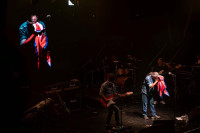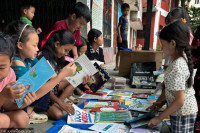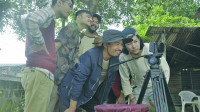Entertainment
Connected by lines: the visible & invisible
Earlier this year a remarkable young artist from Nepal went to Harvard University for a two week sojourn, to represent Nepal, and his work, at the university’s South Asia Institute (SAI), which promotes artists who portray the travails of their society.
Sophia L Pandé
Earlier this year a remarkable young artist from Nepal went to Harvard University for a two week sojourn, to represent Nepal, and his work, at the university’s South Asia Institute (SAI), which promotes artists who portray the travails of their society. The story of how Rabindra Shrestha, a protean artist, talented in both conceptual visualisation and finely wrought execution, is in many ways the story of an entire generation of Nepalis who grew up during the conflict that has defined them and their world view.

Rabindra was born in Bhaktapur, on the day that his father mortgaged their house. The family lost their home a little while later as a result and moved to Chautara, in the neighbouring district of Sindhupalchowk, where Rabindra went to school and learnt his lessons sitting on the floor and listening to a teacher who drew chalk lines on a slate blackboard. His mother, who he reveres as his favourite artist, because she created him, would tie him to her patuka as she did her household chores. Rabindra would draw on the walls of his home, as high as he could reach, with whatever he could find.

Later, as he grew older he would tear the back off of his school notes and copy the illustrations from any book he could find as practice. He struggled with his subjects and his SLC exams, which he took from a school in Sankhu when the family moved to his maternal uncle’s home. Today, a graduate of the Lalit Kala programme at Tribhuwan University, and Kathmandu University’s BFA program, he is astonished and proud to have been selected as a visiting artist to Harvard from a highly competitive pan-Asian pool that selects four artists each year from a hundred and twenty applicants.
Rabindra got his start as he wandered around his native Bhaktapur, a young man marveling at the Paubha work on display that depends on the finest of line drawings. He sought out the master Paubha painter, Prem Man Chitrakar, and apprenticed with him for three months, a groundwork for his innovative future oeuvre that relies on his fascination with and aptitude for lines.

The artist has exhibited widely in Nepal, at every annual National Academy of the Fine Arts (NAFA) competition, and his compositions range from sophisticated, detailed renditions of the amalgamations of Nepali art and architecture to complex, and forward thinking collaboration with masters of Nepali art.
Composition is an example of the mentioned amalgam, and Line and Connection is one of the twenty works that Rabindra collaborated on with the likes of Birendra Pratap Singh, who would complete the lined canvas presented to them with their own highly recognisable, deeply idiosyncratic styles; the pieces are then signed by the collaborating artists on either side highlighting the uniqueness of this special, original partnership that created such a deep connection between two radically different artists and people.
With the earthquake, the artist within Rabindra was moved to create another version of his line compositions, filling in the lines drawn across paper with the finely detailed works of the uncountable artifacts that were damaged; these works are called Earthquake Lines.
I first met Rabindra Shrestha a few months ago at the Taragaon museum, just before his visit to Harvard. Along with the riveting, intricate Earthquake Lines series, he was exhibiting an interactive form of the latest iteration of his love for lines, which he believes are the soul of the universe, showing both the visible and the invisible. He would ask people to stamp their fingerprint on a small white paper card. He would then draw a red line through the fingerprint, sign the card on the back, place the card in a small picture frame, and then hand it to the owner of the finger print, connecting each person symbolically to the next one who offered to participate; it is this wonderfully simple but powerful project that won Rabindra the visiting artist position to Harvard.
While he was in America, he travelled to New York and interacted with visitors to the Museum of Modern Art and the new Whitney Museum downtown, handing out framed fingerprints to delighted participants who then dispersed into the world with a little piece of Nepali art, connected eternally to the artist and the other owners of these little framed fingerprints, this columnist included.
Recently the current Venice Biennale was harshly critiqued by Holland Cotter of the New York Times who called the world famous show, titled “Viva Arte Viva”, and curated by the French Christine Macel, largely politically irrelevant. I cannot help but agree that in times like these, art does have to anchor itself in what is going on around the world, just as Rabindra Shrestha’s does, obliquely but beautifully, creating memorabilia that connects humanity to each other, to the work, and to the world, creating visible and invisible connections that lead to understanding and compassion.
Rabindra Shrestha’s art varies from works created from his own blood, and that of a Maoist cadre, and an army soldier, from his days as a lab technician at a hospital that saw many injured people through the conflict, to conceptual works like a coffee table book of art from around the world with a hatchet cutting through it; the hatchet is decorated with images of Vajrapani and other Nepali iconography, putting art from our country in contention with international art across nations.
Everything this artist has created is relevant, and fuelled by his own passion and pain, informed by a true moral compass and a refusal to back down from the difficult things he sees in front of him. His art therefore speaks volumes and touches everyone who interacts with them; whether they are gentle or confrontational, they always connect to the artist’s humanity.




 8.12°C Kathmandu
8.12°C Kathmandu










